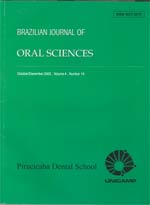
|
Brazilian Journal of Oral Sciences
Piracicaba Dental School - UNICAMP
EISSN:
Vol. 14, No. 4, 2015, pp. 334-340
|
 Bioline Code: os15060
Bioline Code: os15060
Full paper language: English
Document type: Research Article
Document available free of charge
|
|
|
Brazilian Journal of Oral Sciences, Vol. 14, No. 4, 2015, pp. 334-340
| en |
Sodium hypochlorite effects on dentin bond strength and acid-base resistant zone formation by adhesive systems
Francescantonio, Marina Di; Nurrohman, Hamid; Takagaki, Tomohiro; Nikaido, Toru; Tagami, Junji & Giannini, Marcelo
Abstract
Aim: To evaluate the effects of 10% NaOCl gel application on the dentin bond strengths and
morphology of resin-dentin interfaces formed by three adhesives.
Methods: Two etch-and-rinse
adhesives (One-Step Plus, Bisco Inc. and Clearfil Photo Bond, Kuraray Noritake Dental) and one
self-etch adhesive (Clearfil SE Bond, Kuraray Noritake Dental) were applied on dentin according
to the manufacturers’ instructions or after the treatment with 10% NaOCl (ED-Gel, Kuraray Noritake
Dental) for 60 s. For interfacial analysis, specimens were subjected to acid-base challenge and
observed by SEM to identify the formation of the acid-base resistant zone (ABRZ). For microtensile
bond strength, the same groups were investigated and the restored teeth were thermocycled
(5,000 cycles) or not before testing. Bond strength data were subjected to two-way ANOVA and
Tukey’s test (p<0.05).
Results: NaOCl application affected the bond strengths for One-Step Plus
and Clearfil Photo Bond. Thermocycling reduced the bond strengths for Clearfil Photo Bond and
Clearfil SE Bond when used after NaOCl application and One-Step Plus when used as
recommended by manufacturer. ABRZ was observed adjacent to the hybrid layer for self-etch
primer. The etch-and-rinse systems showed external lesions after acid-base challenge and no
ABRZ formation when applied according to manufacturer’s instructions.
Conclusions: 10% NaOCl
changed the morphology of the bonding interfaces and its use with etch-&-rinse adhesives reduced
the dentin bond strength. Formation of ABRZ was material-dependent and the interface morphologies
were different among the tested materials.
Keywords
dental bonding; dentin; dental caries susceptibility; dentin-bonding agents; sodium hypochlorite; scanning electron microscopy
|
| |
© Copyright 2015 - Brazilian Journal of Oral Sciences
Alternative site location: http://www.fop.unicamp.br/brjorals
|
|
